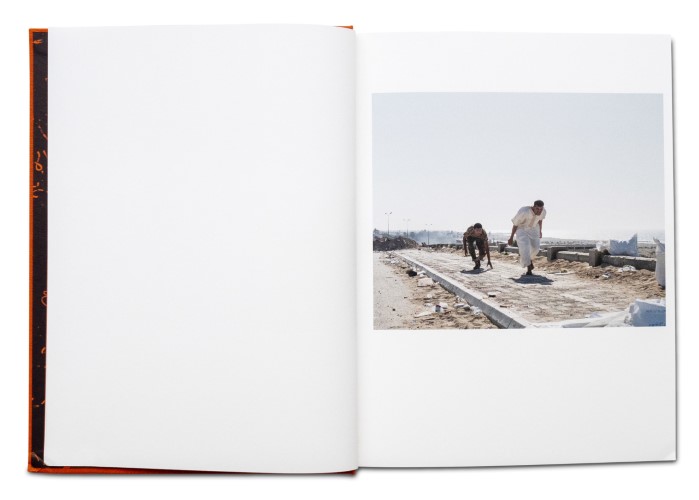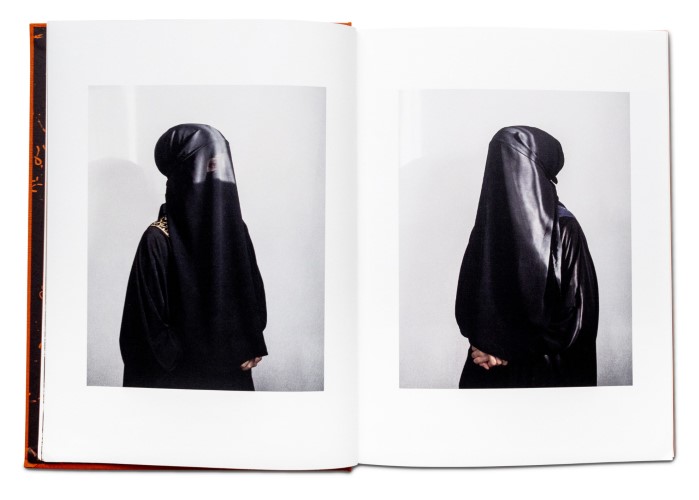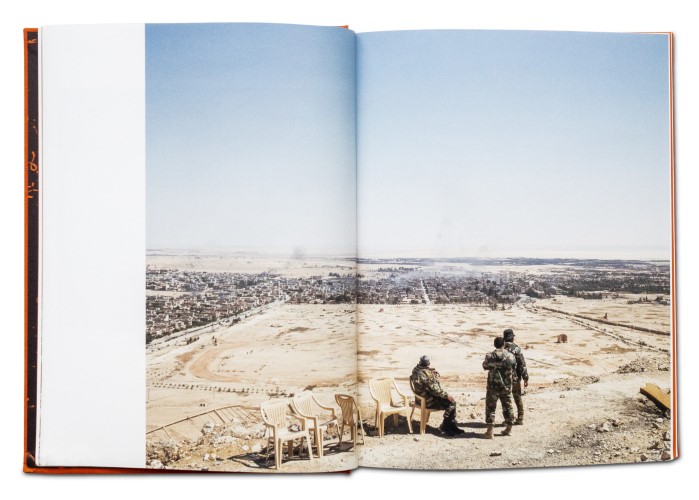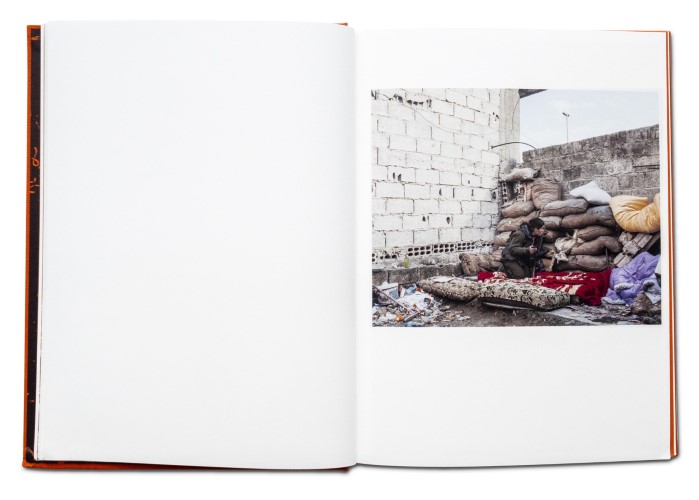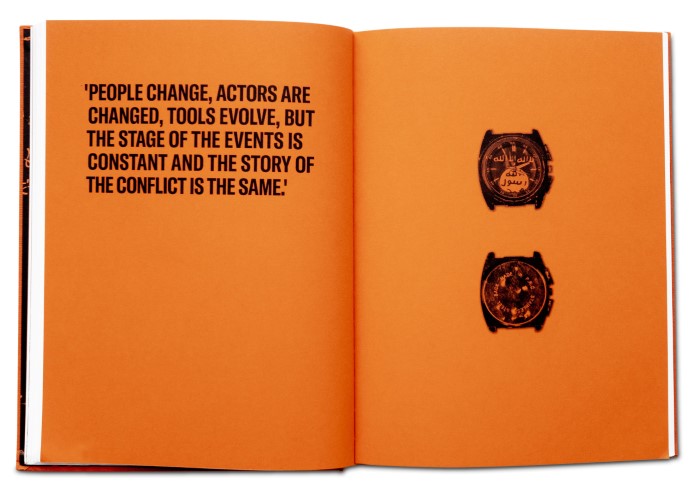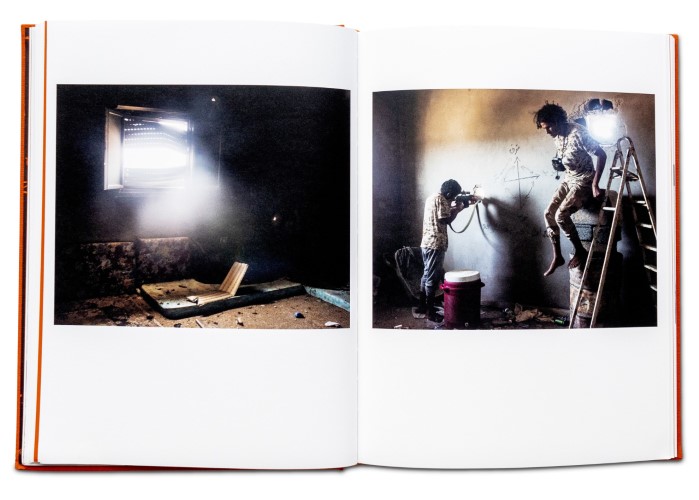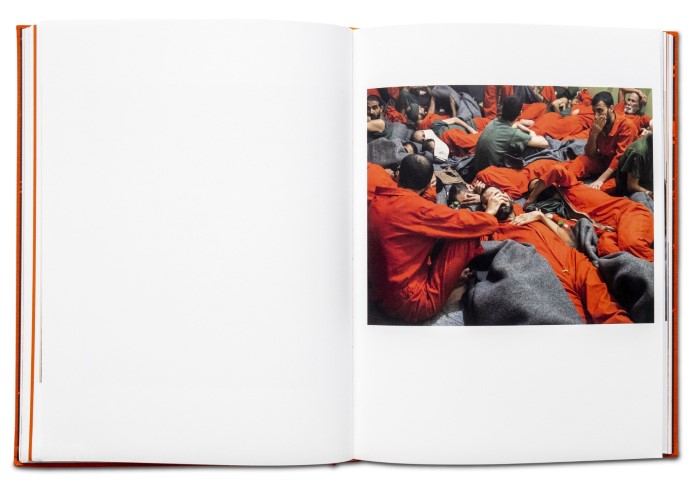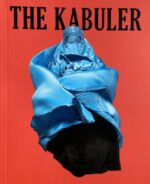L’idée originale de Lorenzo Meloni était d’explorer des façons de capturer les révoltes contre le totalitarisme et les conséquences des entreprises coloniales, comme l’Accord Sykes-Picot de 1916, qui a facilité la création de la carte moderne du Moyen-Orient, en reliant l’histoire des pays en révolte à leur actualité. L’annonce du Califat l’a conduit à se concentrer sur les combattants radicaux qui ont fusionné avec l’État islamique, qui s’est proclamé en 2014. Ce thème a rassemblé les différents récits dont il s’était préoccupé : la montée de l’extrémisme, les liens entre l’histoire et le présent, l’impact continu de la politique étrangère des puissants pays du Moyen-Orient et le sectarisme.
« Mon intention était d’essayer, dans les limites du langage visuel, de comprendre et de rationaliser un conflit – ses racines et son évolution – puis de le replacer dans son contexte historique. et je peux potentiellement comprendre pourquoi de nombreux jeunes en Irak, en Syrie et en Libye ont décidé de s’y joindre ».
Pendant ce temps, Lorenzo Meloni a instinctivement commencé à collecter des fragments physiques et des restes de propagande de l’État islamique, qui étaient généralement rapidement détruits par les soldats et les milices entrant sur le territoire. Il a photographié et conservé ces objets pour leur valeur historique. Dans le processus de création de ce livre, Meloni a arrangé des milliers de photographies sur les planchers et les murs pour réfléchir à la façon de dépeindre ce conflit sans trop le simplifier, et a intercalé ces fragments dans la séquence d’images.
« Le mot qui revenait dans mon esprit était « fragmentation », parce que les pays dans lesquels je travaillais étaient tous profondément divisés par des ethnies, des confessions, des factions tribales, des territoires et des affiliations politiques. Le terme « fragmenté » semble aussi évoquer la violence de la guerre, où les gens sont souvent tués par des éclats d’obus à la suite d’explosions. « Fragmenté » semblait aussi résumer mon point de vue,
et des représentations visuelles des événements dont j’ai été témoin. Cela m’a inspiré à créer une séquence dans laquelle des photographies du conflit sont interrompues par des images d’objets trouvés dans les décombres de la guerre et des extraits de lettres, de graffitis et de publications de membres du groupe État islamique. Tout récit linéaire dans cette œuvre est perpétuellement interrompu par ces fragments d’une entité territoriale maintenant détruite. D’une entité territoriale maintenant détruite, un autre État défaillant, mais avec une idéologie qui a imprégné le monde entier et inévitablement pas été éradiqué avec ses territoires. Les images forment une boucle – une répétition constante – à travers le livre, reflétant mes expériences sur le terrain. Bien qu’elle soit perçue comme pleine d’action et d’adrénaline, la guerre est en fait très répétitive, et même si je travaille dans différents pays, je me suis souvent retrouvée à photographier des scénarios semblables. »
Finaliste pour le prix du meilleur livre de photographie de l’année 2022 dans la catégorie International.
Shortlisted for the PHotoESPAÑA Best Photography Book of the Year Award 2022 in the International category.
Lorenzo Meloni’s original idea was to explore ways of capturing revolts against totalitarianism and the aftermath of colonial undertakings—such as the Sykes-Picot Agreement of 1916, which facilitated the creation of the modern map of the Middle East—by linking the history of countries in revolt with their current events. The announcement of the Caliphate led him to focus on the radical fighters who coalesced into the Islamic State, which proclaimed itself in 2014. This focus brought together the different narratives he had been concerned with: rising extremism, the links between history and the present, the continuing impact of the foreign policy of powerful Middle Eastern countries, and sectarianism.
‘My intention was to try, within the limits of visual language, to understand and rationalise a conflict—its roots and its evolution—and then place it in its historical context. The emergence of the Islamic State was a logical development, and I can potentially understand why many young people in Iraq, Syria and Libya decided to join it’.
During this time, Lorenzo Meloni instinctively began collecting physical fragments and remnants of Islamic State propaganda, which were usually quickly destroyed by soldiers and militias entering the territory. He photographed and preserved these artefacts for their historical value. In the process of creating this book, Meloni arranged thousands of photographs on floors and walls to think about how to portray this conflict without oversimplifying it, and interspersed these fragments within the sequence of images.
‘The word that recurred in my mind was ‘fragmentation’, because the countries I worked in were all deeply divided by ethnicities, faiths, tribal factions, territories and political affiliations. Fragmented’ also seemed to evoke the violence of war, where people are often killed by shrapnel from explosions. Fragmented’ also seemed to sum up my point of view,
and visual representations of the events I had witnessed. This inspired me to create a sequence in which photographs of the conflict are interrupted by images of objects found in the rubble of war and excerpts of Islamic State members’ writing from letters, graffiti and publications. Any linear narrative in this work is perpetually interrupted by these fragments of a now destroyed territorial entity. Of a now-destroyed territorial entity, another failed state, but with an ideology that has permeated the entire world and inevitably not been eradicated with its territories. The images form a loop – a constant repetition – through the book, reflecting my experiences in the field. Despite being perceived as full of action and adrenaline, war is actually very repetitive, and although I work in different countries, I have often found myself photographing similar scenarios”’.
Lorenzo Meloni (1983 – Rome) is known for his searing, artfully drawn photography covering conflicts in the Middle East. Though he is often working on the frontline—he has covered some of the most pivotal battles in the war against the Islamic State—he is also concerned with deeper themes, such as history and post-colonialism. In 2011, he finished his photography studies and immediately joined Contrasto, a major Italian photographic agency. He lived in Beirut from 2012 to 2014 and dedicated himself to long-term projects including the aftermath of the fall of Gaddafi in Libya, the conflict in Syria and its impact in Lebanon, between 2014 to 2016. His work currently focuses on the consequences of the Sykes-Picot agreement and the military and political intervention of the West in the Middle East. His photographs are held in private collections such as Collection Banco Sabadell and Incite project. Meloni’s work has been exhibited in festivals worldwide including the Venice Biennale, Visa pour L’Image, Les Rencontres d’Arles, Boutographies and Fotoleggendo and has been featured in global publications including TIME, Le Monde, The Telegraph, and Vanity Fair. Meloni became a full member of Magnum Photos in 2020.


